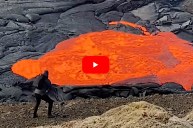It turns out there are ghosts at sea. Okay, maybe not actually ghosts. But apparently ghost islands! NASA became alarmed after its satellites spotted a mysterious ghost island that then disappeared.
The island was located somewhere in the Caspian Sea. NASA picked up an image off the island off the coast of Azerbaijan. This was amid the 2023 mud volcano eruption in the region. However, just a year later, the island disappeared like an apparition.
"Powerful eruptions of the Kumani Bank mud volcano have produced similar transient islands several times since its first recorded eruption in 1861," it explained. "Also known as Chigil-Deniz, the feature is located about 25 kilometers (15 miles) off the eastern coast of Azerbaijan."
Images show the region across three separate dates — November 18, 2022, February 14, 2023, and December 25, 2024. In the first image, the volcano appeared below the surface. In the second, an island had formed in its spot due to the eruption. It measured approximately 1,300 feet across. However, by the end of 2024, that island had all but disappeared. Hence the nickname ghost island for these temporary spots of land.
It's not the first time something like this has happened in the region, and it probably won't be the last. NASA highlighted other similar landmasses tied to eruptions in the region.
NASA Highlights Ghost Island
"A May 1861 event resulted in an island just 87 meters (285 feet) across and 3.5 meters (11.5 feet) above the water," NASA said. "This one eroded away by early 1862. The strongest eruption, in 1950, produced an island 700 meters (2,300 feet) across and 6 meters (20 feet) high."
However, officials say that more studying and research is needed on mud volcanoes and their causes. There's a large number in the Azerbaijan region.
"Geologists have tallied more than 300 in eastern Azerbaijan and offshore in the Caspian Sea, with most of those occurring on land," NASA said. "The region falls within a convergence zone where the Arabian and Eurasian tectonic plates are colliding."
Officials highlighted the potential hazards of mud volcanoes.
"It is uncertain if the 2023 Kumani Bank eruption was fiery, but past eruptions of this and other nearby mud volcanoes have sent towers of flame hundreds of meters into the air," NASA added.




